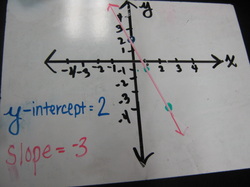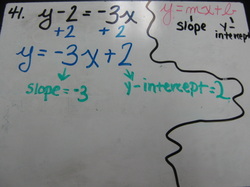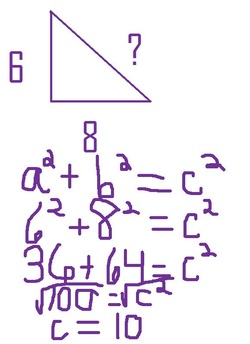When writing an equation for a perpendicular line, there are some things that you need to remember. First, remember that lines that are perpendicular have slopes that are negative reciprocals. Perpendicular lines should always form a right angle. So, if they don’t form a right angle you know something is incorrect.
When writing an equation for parallel lines, you need to know that the parallel lines have the same slope. Parallel lines have to have different y-intercepts in order to be parallel. Any two vertical lines are parallel.
Here are the three types of linear equations we have studied so far during Unit 6:
y=mx+b is the slope intercept form.
An example would be: y=3x+4
Ax+By=C is the standard form.
An example would be: 4x+7y=19
(y-y1)= m(x-x1) is the point slope form.
An example would be: y-3=-2/3(x-9)
Step 1: First you write the original problem.
Step 2: You have to add 2 to both sides to make it look like the equation needed to find slope and the y- intercept.
Step 3: re‐write the problem.
Step 4: The y‐intercept would be 2 and the slope would be -3.
Step 5: Then graph
This is your new blog post. Click here and start typing, or drag in elements from the top bar.
When we learned Lesson 6–2, we found it helpful to know these vocabulary terms:
Linear Function- A function that graphs a line
Parent Function- The simplest equation of a function
Linear Parent Function- The equation y = x or f(x) = x
Linear Equation- An equation that models a linear function
y‐intercept- y‐coordinate of the point where a line crosses the y‐axis
Slope‐Intercept Form- y = mx + b
On my recent math test I got a strategic thinking or higher level problem incorrect. This is the problem:
In the diagram y=√37. Use Pythagorean Theorem to find x. Express x as a radical expression in simplest form. Show your work.
For the triangle the measurements are A=6, B=6.
The Pythagorean Theorem is a²+b²=c²
So 6²+6²=c²
36+36=c²
72=c²
√72=√c
Now you have to write c or x as a radical expression.
Use the perfect squares square root of 9 to be expressed as
√72=√8*√9
Simplify
The square root of 8 is √2*√4 which could be simplified to √2*2 because the √4 is 2. The square root of 9 is 3.
This is written as 3*2*√2
6√2 is the answer.
Learn to use Algebra to solve a travel problem. This podcast was made by Amanda, Shauna, and Meagan.
Section 3-9
The Pythagorean Theorem
In this section, we learned all about the Pythagorean theorem of triangles.
What is the hypotenuse of a triangle? What are the legs of a triangle? What in the world is the Pythagorean theorem????
Look at the blue lines of the triangle. The lines both intersect each other at a 90 degree or right angle. These lines are the legs of the triangle. The leg of a triangle is one of the sides that make up the right angle in a right triangle.
The orange line is not the leg of the triangle. Instead, it is the hypotenuse. The hypotenuse of a right triangle is the side opposite of the right angle. It is also the longest side of the triangle.
Once you know the sides of the triangle, you can plug in the numbers to the Pythagorean theorem. The Pythagorean theorem is the relationship of the lengths the sides of a right triangle. The formula is in blue and orange to help you know where the sides go in the equation. Let’s try an example:
In class we just competed section 3-6. One thing we learned was how to define a variable in terms of another. To solve this problem you have to decide which unknown quantity the variable will represent. Then you have to show the other quantity in terms of that variable. Another thing we learned is dealing with consecutive integers. First you have to define a variable before describing the equation in words. Make a variable the first unknown integer and then define the other numbers in terms of that first unknown integer. Last but not least we learned how to solve problems with same direction travel, opposite direction travel, and round trip travel. The first step is to define the missing variables in the problem. Then you have to create a table to relate the numbers that includes rate time and distance because rate times the time equals the distance. You then write out and solve the equation to get your final answer.




 RSS Feed
RSS Feed